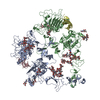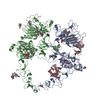+Search query
-Structure paper
| Title | Structural dynamics of the active HER4 and HER2/HER4 complexes is finely tuned by different growth factors and glycosylation. |
|---|---|
| Journal, issue, pages | Elife, Vol. 12, Year 2024 |
| Publish date | Mar 18, 2024 |
 Authors Authors | Raphael Trenker / Devan Diwanji / Tanner Bingham / Kliment A Verba / Natalia Jura /  |
| PubMed Abstract | Human Epidermal growth factor Receptor 4 (HER4 or ERBB4) carries out essential functions in the development and maintenance of the cardiovascular and nervous systems. HER4 activation is regulated by ...Human Epidermal growth factor Receptor 4 (HER4 or ERBB4) carries out essential functions in the development and maintenance of the cardiovascular and nervous systems. HER4 activation is regulated by a diverse group of extracellular ligands including the neuregulin (NRG) family and betacellulin (BTC), which promote HER4 homodimerization or heterodimerization with other HER receptors. Important cardiovascular functions of HER4 are exerted via heterodimerization with its close homolog and orphan receptor, HER2. To date structural insights into ligand-mediated HER4 activation have been limited to crystallographic studies of HER4 ectodomain homodimers in complex with NRG1β. Here, we report cryo-EM structures of near full-length HER2/HER4 heterodimers and full-length HER4 homodimers bound to NRG1β and BTC. We show that the structures of the heterodimers bound to either ligand are nearly identical and that in both cases the HER2/HER4 heterodimer interface is less dynamic than those observed in structures of HER2/EGFR and HER2/HER3 heterodimers. In contrast, structures of full-length HER4 homodimers bound to NRG1β and BTC display more large-scale dynamics mirroring states previously reported for EGFR homodimers. Our structures also reveal the presence of multiple glycan modifications within HER4 ectodomains, modeled for the first time in HER receptors, that distinctively contribute to the stabilization of HER4 homodimer interfaces over those of HER2/HER4 heterodimers. |
 External links External links |  Elife / Elife /  PubMed:38498590 / PubMed:38498590 /  PubMed Central PubMed Central |
| Methods | EM (single particle) |
| Resolution | 3.31 - 4.27 Å |
| Structure data | EMDB-41883, PDB-8u4i: EMDB-41884, PDB-8u4j: EMDB-41885, PDB-8u4k: EMDB-41886, PDB-8u4l: |
| Chemicals |  ChemComp-NAG: |
| Source |
|
 Keywords Keywords | MEMBRANE PROTEIN / TRANSFERASE / Receptor Tyrosine Kinase |
 Movie
Movie Controller
Controller Structure viewers
Structure viewers About Yorodumi Papers
About Yorodumi Papers











 homo sapiens (human)
homo sapiens (human)